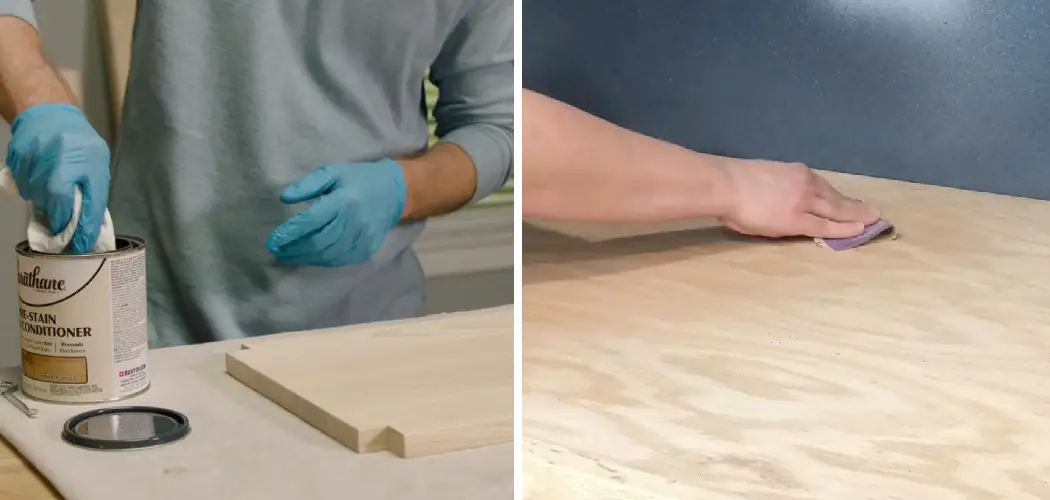Do you love the look of wood but worry that staining it can be labor-intensive? Don’t fear—staining your wood furniture or DIY project piece doesn’t have to involve complicated steps. Water based stain is an easy way to give your items a beautiful, vibrant finish without sanding or intense hard-to-follow instructions.
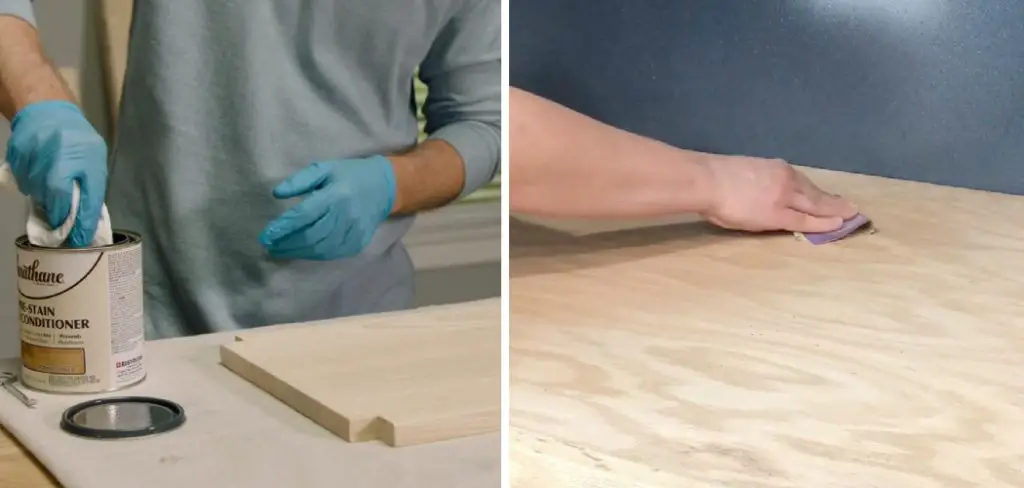
This guide will show you how to apply water based stain easily and effectively without sacrificing quality. With just a few simple steps, you’ll have gorgeous, stained wood pieces in no time.
With this guide, we’ll show you how simple it can be to apply water based stain and ensure that anyone with even minimal woodworking experience can achieve professional-looking results for their projects!
Why Choose Water Based Stain?
Before we dive into the application process of water based stain, let’s discuss why it may be the right choice for your project. Water based stains are becoming increasingly popular because of their minimal odor, quick drying time, and easy clean-up. They also offer a wide range of color options and can be easily mixed to create custom shades.
Water based stain is also environmentally friendly as it doesn’t contain harmful chemicals like oil-based stains do. This makes it a safer option for both the user and the environment.
Another advantage of water based stain is that it can be applied to both indoor and outdoor projects, making it a versatile choice for all your staining needs.
Now that you know the benefits of using water based stain, let’s get into the application process.
What Will You Need?
To successfully apply water based stain, you will need the following materials:
- Water based stain of your choice
- Clean cloth or brush for application
- Gloves and protective eyewear (optional)
- Sandpaper (if needed)
- Drop cloth or newspaper to protect your work surface
Now that you have all the necessary materials let’s get started on staining!
10 Easy Steps on How to Apply Water Based Stain
Step 1: Prepare Your Workspace
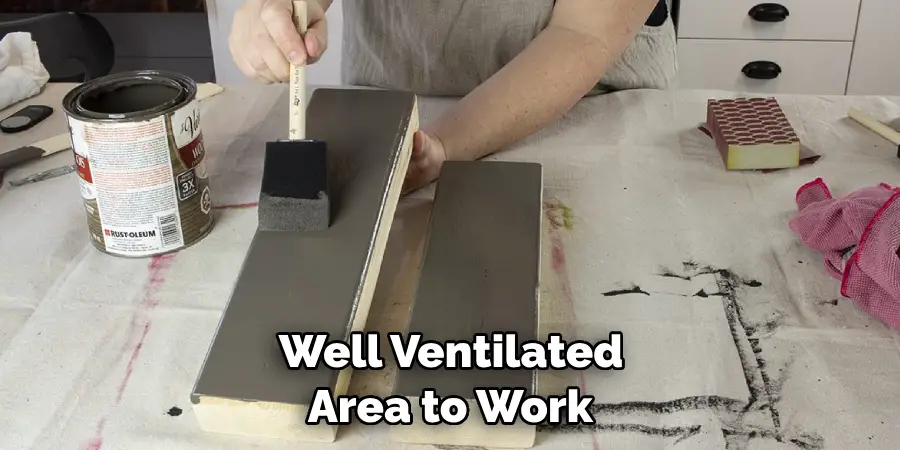
First things first, make sure you have a well-ventilated area to work in, as even water based stains can emit some fumes. Place a drop cloth or newspaper under the wood piece to avoid staining the floor or work surface.
Arrange all your materials within arm’s reach and ensure that you have enough lighting to see your work. If you’re working on a small piece, consider using a table or workbench, while larger projects may require a spacious ground area. Remember, preparation is key to a smooth and efficient staining process.
Step 2: Prepare the Wood
Before applying the stain, preparing your wood for staining is important. If your wood surface is pre-finished, gently sand the surface with 220-grit sandpaper to remove the old finish and help the water based stain adhere better. If your wood is untreated, you should clean any dirt or dust off it. Once done, wipe the surface with a clean, dry cloth to remove any residual dust. This step will ensure that your stain goes on smoothly and evenly.
Step 3: Apply the Water Based Stain
Now, it’s time to apply the water based stain. Dip a clean cloth or brush into the stain. Begin applying the stain onto the wood surface, following the direction of the wood grain. It’s best to start at one end and work to the other, maintaining a wet edge to prevent lap marks.
Apply the stain evenly across the surface, ensuring not to over-saturate the wood. Less is more when applying stain – you can add another coat later if you desire a darker color. Once you’ve covered the entire surface, let the stain sit for a few minutes (refer to the stain manufacturer’s instructions for exact timing). This allows the stain to penetrate into the wood, ensuring a rich, deep color.
Step 4: Wipe Off Excess Stain
After allowing the stain to penetrate into the wood, take a clean, dry cloth and gently wipe off any excess stain from the wood surface. Follow the direction of the wood grain as you wipe. Removing the excess is essential to prevent the stain from becoming sticky and ensure a smooth, even finish. Remember to flip or replace your cloth frequently to avoid reapplying the wiped-off stain back onto the wood.
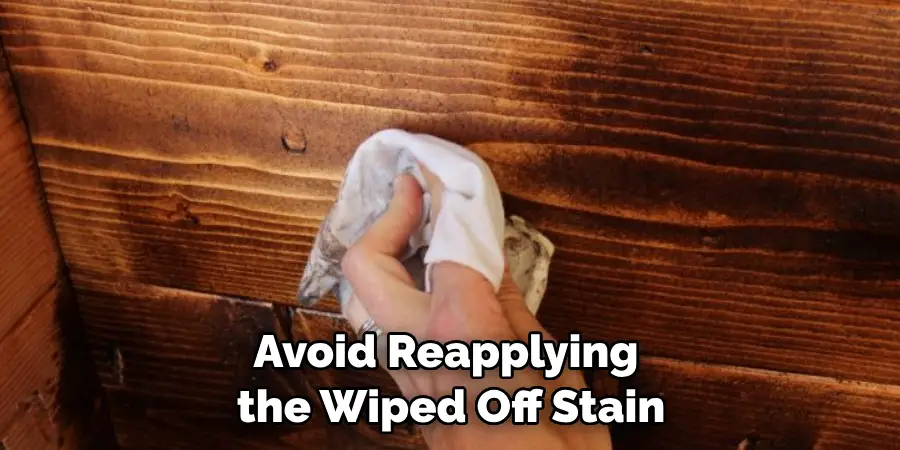
Once you’ve wiped the entire surface, allow the stained wood to dry completely. Depending on the temperature and humidity levels, this may take a few hours or longer. Always refer to your stain manufacturer’s instructions for recommended drying times.
Step 5: Apply Additional Coats (If Desired)
You can skip this step if you’re satisfied with the color after the first coat. However, if you want a deeper and richer color, apply an additional coat(s) of stain. Before applying another coat, make sure the previous one is dehydrated. Follow the same process as in Steps 3 and 4 for each additional coat – apply the stain, let it penetrate, and then wipe off the excess.
Remember to allow each coat to dry completely before moving on to the next one. This step is all about achieving the desired color – the choice is yours on how dark or light you want your finish to be. After applying the final coat, let it dry thoroughly.
Step 6: Seal the Stain
Once your last coat of stain has dried completely, it’s now time to seal the stain to protect your wood piece and enhance its durability. For this step, you’ll need a water-based polyurethane sealer. Using a clean brush, apply a thin coat of sealer onto the stained wood, following the direction of the wood grain.
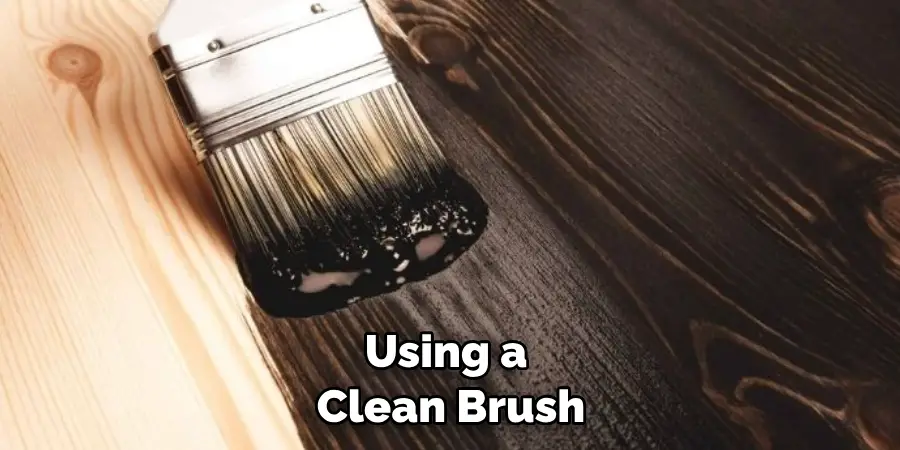
Be careful not to over-apply the sealer as it can cause drips or streaks. Allow the sealer to dry according to the manufacturer’s instructions. Once dry, lightly sand the surface with fine-grit sandpaper, then wipe off the dust with a clean cloth.
Step 7: Apply a Second Coat of Sealer
After the first coat of sealer has dried and been lightly sanded, it’s time to apply a second coat. This will further protect your piece and give it a polished look. Repeat the process from Step 6: use a clean brush to apply the sealer, taking care not to over-apply, and then let it dry according to the manufacturer’s instructions.
This second coat of sealer solidifies your stained wood’s protection against weather, wear, and tear. Once this coat has dried completely, your staining project is complete! Now, you can enjoy the new look of your wood piece, knowing you’ve successfully learned how to apply water based stain.
Step 8: Cleaning Up
Once you have successfully applied the water based stain and it has dried completely, it’s time to clean up. Start by properly storing any leftover stain for future use; make sure the lid is tightly secured and store it in a cool, dry place away from direct sunlight.
Clean your brushes and other tools with warm, soapy water, ensuring all stain residue is removed. Dispose of used clothes and gloves responsibly. Lastly, remove the drop cloth or newspaper from your work area, ensuring any stained spots are dry to avoid transferring the color elsewhere.
Step 9: Maintenance and Care
After your staining project is complete, proper maintenance is crucial to preserve the beauty and longevity of your wood piece. Keep the item clean and dust-free by regularly wiping it with a damp cloth. Avoid using harsh cleaning chemicals, as these can damage the finish.

Consider using a protective cover for outdoor pieces to shield them from extreme weather conditions. If, over time, the finish starts to fade or peel, you may need to reapply the stain and sealer. Always follow the manufacturer’s instructions for care and maintenance.
Step 10: Enjoy Your Work
Now that you’ve completed all the steps in applying a water based stain, it’s time to enjoy the fruits of your labor. Whether you’ve transformed a piece of furniture, a deck, or a wooden accessory, take a moment to appreciate the rich, new color and smooth finish. Remember, applying a water-based stain not only enhances the aesthetic appeal of your wood piece but also lends a protective layer, ensuring its durability for years to come.
By following these steps, you’ll be able to confidently apply water based stain on any wood surface. You can achieve various shades and finishes with practice and patience, giving your wooden pieces a unique touch.
5 Additional Tips and Tricks
- Test First: Always test the water based stain on a small, inconspicuous area or a scrap piece of wood before applying it to the entire project. This will give you a sense of how the stain looks on that specific type of wood.
- Sand Smoothly: Prior to applying the stain, ensure the wood surface is smoothly sanded. Rough areas can absorb more stains, resulting in uneven coloration.
- Apply Evenly: Ensure the stain is applied evenly over the wood surface. Use a quality brush or a lint-free cloth to evenly spread the stain in the direction of the wood grain. This will help avoid blotches and streaks.
- Consider Multiple Coats: If a darker or more intense color is desired, consider applying multiple coats of water based stain. Let each coat dry completely before adding another layer.
- Protect and Seal: Once the stain has been applied and has dried completely, protect and seal the wood surface with a clear finish or varnish. This will help preserve the color and prevent any damage to the stain.
Once you have completed these steps, you will have a beautifully stained piece of wood that is sure to impress. With these tips and tricks, you can confidently apply water based stain and achieve professional-looking results every time!
5 Things You Should Avoid

- Avoid Neglecting Safety: Always wear safety glasses and rubber gloves when working with stains. This will protect your eyes and skin from any accidental splashes.
- Avoid Rushing: Do not rush the staining process. Take your time to apply the stain evenly and allow it to dry properly between coats. Rushing through the process can lead to a poor finish.
- Avoid Ignoring Weather Conditions: Inappropriate weather conditions can impact the drying time and finish of the stain. Avoid staining outdoors on excessively hot, cold, or humid days.
- Avoid Using Old or Contaminated Stain: Always check the expiration date of your stain. Using old or contaminated stains can lead to an uneven color and finish.
- Avoid Skipping Clean-Up: After you have completed the staining process, ensure you clean up properly. Dispose of used clothes and brushes in a safe and environmentally friendly manner. Never pour leftover stains down the drain.
Avoiding these common mistakes can help ensure a successful staining project, leaving you with a beautiful, long-lasting finish.
Can You Apply the Stain With a Sponge?
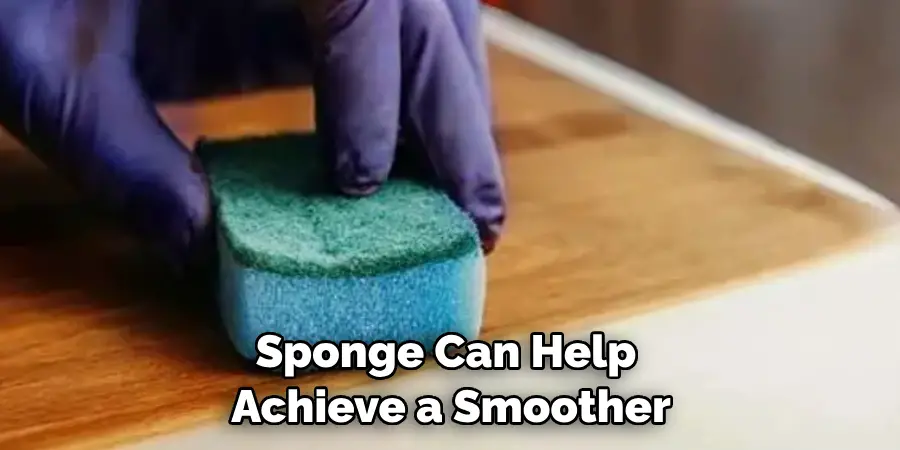
Yes, you can apply water based stain with a sponge. Using a sponge can help achieve a smoother and more even stain application. However, using a clean and lint-free sponge is important to avoid any debris or particles getting stuck in the stain and causing an uneven finish. Additionally, wipe off excess stains with a clean cloth after applying a sponge to avoid any streaks or blotches.
Remember that using a sponge can also use more stain than other application methods, so be prepared with enough stain for your entire project. Applying water-based stain with a sponge can be a useful technique for achieving a beautiful finish on your wood projects. So go ahead and give it a try!
Conclusion
In conclusion, how to apply water based stain correctly and appropriately can be a complex process. To ensure you have the same result each time and avoid costly mistakes, follow the steps in this blog post carefully.
Additionally, use quality materials and equipment when possible to ensure your finished product is of the highest quality. Finally, practice regularly to refine your technique and become an expert in applying water-based stains. With the tips in mind and a little effort, following these guidelines will give you a perfect finishing result every time. Choose to take on this challenge today – it’s worth it!
Now that you are more informed on the ins and outs of applying water-based stains correctly, why not give it a try? You won’t regret taking the plunge into understanding this necessary process for woodworking projects – it truly pays off!

